
Surf birds at Cape Hatteras
June 28th, 2012
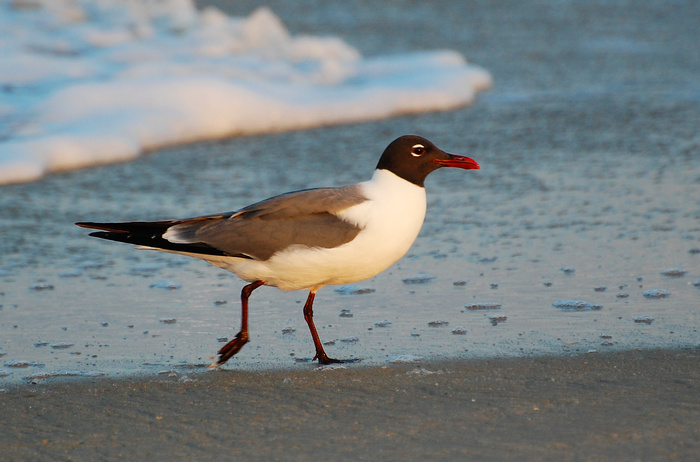
Laughing Gull, wallpaper available
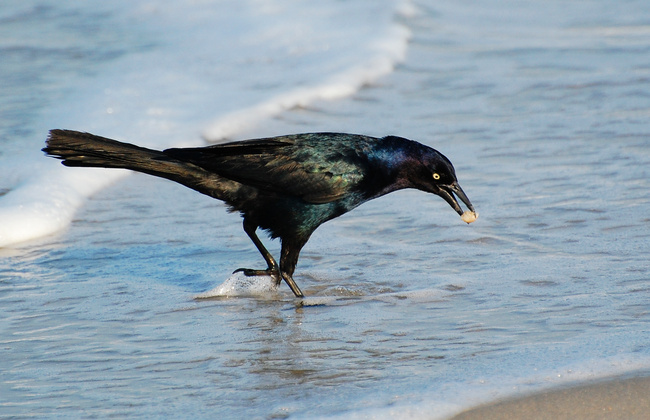
1680x1050 wallpaper
Boat-Tailed Grackles are crow-sized blackbirds adapted to a coastal lifestyle. Of the various songbirds on Hatteras, few of them show up on the outer beaches. Boat-Tailed Grackles are a notable exception. They forage at the edge of the surf, digging for small invertebrates. This week they were fattening themselves on mole crabs (a.k.a. sand bugs), little beetle-shaped crabs that burrow in wet sand. When coquina clams (another burrower at surf edges) are abundant, they'll eat those, using their beaks like nutcrackers.
When a wave washes in, they leap and flutter to keep their balance.
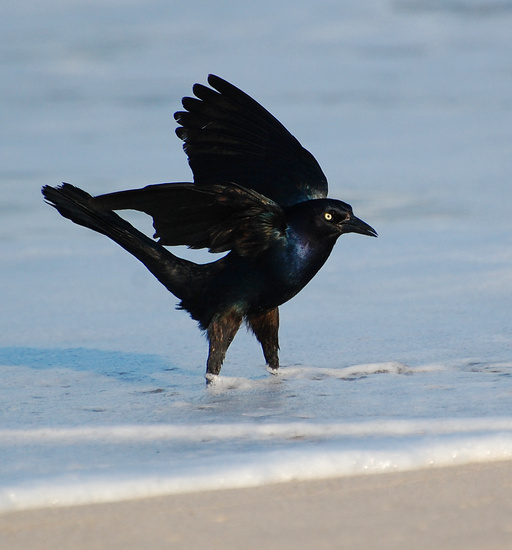
1680x1050 wallpaper
( More (Black-Bellied Plover) )
If nothing else, it makes for good stories!
June 27th, 2012
We're back from vacation. It was a vacation of extremes, high and low--sometimes overlapping.
On the second day after our arrival at Hatteras, Mike and I made an hour-and-a-half trip to the mainland to Palmetto-Peartree Reserve in search of Red-Cockaded Woodpeckers, a rare and endangered species linked to old-growth pine savannahs. They are unusual in a number of ways, one being that they are the only North American woodpecker to dig their nest holes out of living wood, using the resulting flow of sticky sap as a deterrent against tree-climbing predators such as rat snakes.
I had no idea how off the grid PPR is. There were no outhouses, no rangers, no cars going by, not a soul in sight other than us. We drove down a muddy, slippery road with insufficient gravel, and ended up sliding into the ditch. We had to walk back to the main road before we could even get a signal on the cell phone to call a tow truck to pull us out, to the tune of $150 because he knew he had us over a barrel. We forgot to bring any sort of food (despite having eaten a very small breakfast), and left the sunblock in the car and forgot about it until we'd hiked a half hour and were now under the blazing midday sun in an unshaded wetland. Deer flies were abundant, and while the Off more or less kept them at bay, it didn't prevent me from waking up a few hours after our return with a tick embedded in my belly.
Lesson learned: do not trifle with mother nature. At least not in North Carolina.
For our trouble, I did not see any Red-Cockaded Woodpeckers. (Well, I may have. But far from satisfying and not enough to lifelist it.) But there were payoffs. It was one of the wildest places I've ever encountered, with tall, spindly, ancient-looking Loblolly pines, rich wetlands with reed beds towering over us, and pristine vistas over the Albemarle Sound. Green Herons, whom I have always thought of as shy and solitary birds that skulk around pond edges, were abundantly visible. They constantly flew back and forth across the road perching in those ancient pine trees. I'm sure they had a rookery up there.
For me, the greatest pleasure in encountering a bird is when it is utterly wild. I've seen many Osprey at Outer Banks, nesting on man-made platforms on top of man-made pylons, and paying humans little mind because they're long used to the sight of us. The pair of Osprey we met at PPR were nesting in a treetop, and they acted like they'd never seen a human being before in their lives. Though we were hundreds of feet away from their nest and could not have gotten closer without wading through knee-deep water, our presence incensed them. They circled over us calling franticly.
The Virginia part of my vacation was extremely buggy. Not mosquitos--mosquitos are trivial. Ticks and chiggers. The woods around and near my parents' neighborhood are excellent for birding, but they are also heavily infested. Over the course of the week I picked on the order of twenty ticks off my body, ranging from tiny pinpoint-sized ones (Lyme Disease!) to big ones with spots on them (Rocky Mountain Spotted Fever!) I also got a rather nasty case of chiggers that left oozing, furiously itching sores all over my legs and middle, one of which is still scabbed over. However, in the very place that I probably picked up those chiggers (Swift Creek Trail), I got a thrilling life bird, Hooded Warbler, a gorgeous southeastern warbler with a black cowl encircling a vivid yellow cheek. (I didn't get any photos, so click on the link if you want to see a picture.) Was it worth it? Yes, ten times over.
In the coming days I'll share some of my Cape Hatteras photos.
King of butterflies
June 7th, 2012

1680x1050 wallpaper
Nesting Killdeer at South March
June 4th, 2012
In the east part of South March Conservation Forest is a large beaver pond called Heron Pond. At its north shore is some of the most unique geology I've seen in Ottawa: a vast sandstone barren, dotted with short pine trees, and encrusted with a rich variety of mosses, lichens, grasses and wildflowers. It's been said that the plain dates back to the Paleozoic era. I've seen a pair of nighthawks courting above it: the male flying close to the female, then diving straight down and veering up suddenly with a *whoosh* of his wings (you can hear it from a distance.) Nighthawks are a species in decline and considered At Risk in Canada, and I find this rather significant as that part of the forest is not conservation area: it's owned by a developer and could be lost in the future.
Another species I've found breeding on the sandstone plain--though I doubt any conservationists will take interest is this one--is Killdeer! Killdeer are the most successful plovers in North America, and that's because they're so at ease with the changes humans make to the environment. I've seen them in farmland, equestrian parks, on manicured lawns and in parking lots, but this was the first time I'd seen breeding killdeer in an utterly wild, natural environment...and there was something enchanting about that.
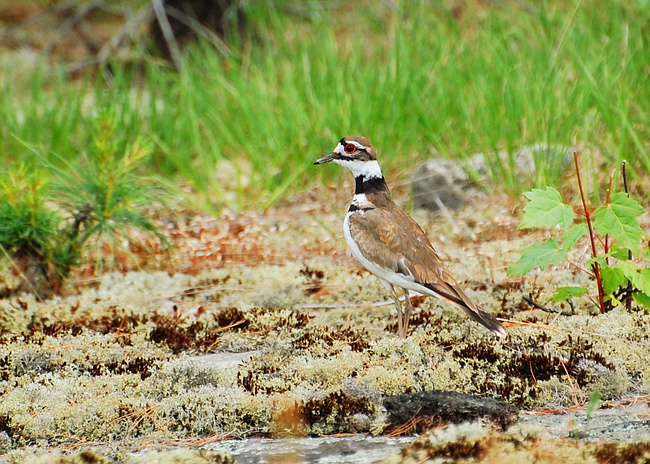
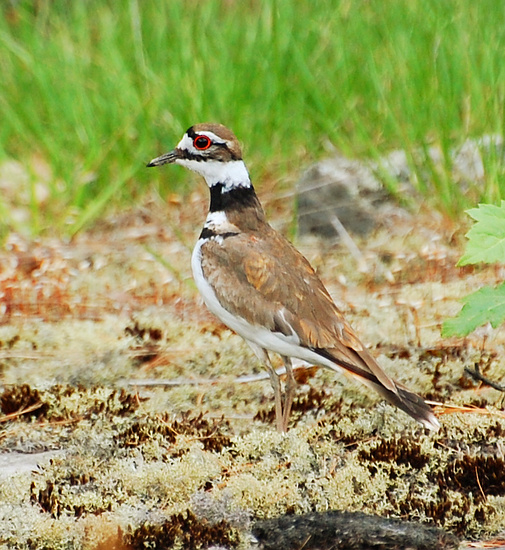
Because killdeer nest on open ground, their eggs and young are vulnerable. So they've evolved means to distract predators away from the nest, generally by acting helpless. If the predator thinks it can easily catch the adult, why bother with the young? It's easy to feel like a louse while pursuing a killdeer for a photo: they cry so pitiably. They sound like they're in such deep distress. One tries to remember that the deep distress is an act. Real distress would be if you got close to their nest--and as long as you follow where they lead, that's sure not to happen.
The crown jewel of the repertoire is the famous broken wing display. The parent killdeer sits down, fans its eye-catching orange tail, sticks its wings out at odd angles, and flops around like a poor, pathetic fish out of water.
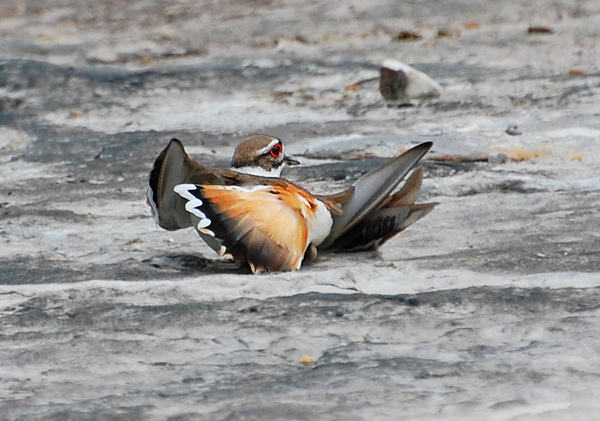
The sap tapper
June 2nd, 2012
My next two posts come from a leisurely afternoon hike through South March Conservation Forest. I continue to be thrilled at the wildness and biodiversity of these woods, which rival anything I've seen in the Gatineau.

This was the tamest Yellow-Bellied Sapsucker I'd ever found. He didn't fly away as I approached, but continued to tap away at his sap wells while I snapped pictures. Sapsuckers are specialized woodpeckers. Those rows of small holes are his work. He'll lick up any sap that leaks out, as well as any insects that are attracted to it.
Sapsuckers are considered a "keystone species", important to the survival of many other birds and animals, not least hummingbirds. When flower nectar is in short supply in spring, sapsucker-made wells can help tide them over.
Katydid nymph on hawkweed
May 31st, 2012
I'm sure insectophobes would call this "a good flower spoiled." But I'm rather taken with it.

1680x1050 wallpaper
A Gift
May 29th, 2012
Black-Billed Cuckoos are shy, elusive birds. In five years of enthusiastic birding, I'd only ever seen one once--and I only saw him because my birding companion played a recorded call, convincing him that a rival male was in his territory.
Until today! I was hiking Greenbelt Pathway West when this fellow came right out in the open. He had apparently found an oak tree full of food (perhaps caterpillars--cuckoos have a voracious appetite for them), and was too caught up in his feeding frenzy to bother hiding from me.

It really felt like a gift from the universe.
Pink Ladyslippers
May 25th, 2012

I still remember the day, as a child, I found one lone pink ladyslipper growing in the woods behind my house. It seemed rare and special to me even then. That was before I knew why they're so uncommon. They require acidic soil, they're slow to develop, and if picked, they will not regrow. Most interestingly, ladyslippers can't sprout without the help of a symbiotic fungus. Their seeds are tiny and bear no food supply for the developing plant. The fungus penetrates the seed and nourishes it. Payback comes later when the fungus extracts nutrients from the roots of the mature plant.
Until recently, Mer Bleue bog was the only place I knew in Ottawa to find this flower. I've since discovered that the South March Conservation Forest (a wonderful natural area near our new home) has them in abundance!
Drama at the Nortel wetland
May 18th, 2012
Yesterday in the Nortel woods, I was walking along where some stones traverse a wet spot on the path, and heard a Sedge Wren singing. Sedge Wren is a small, shy and secretive bird, rare in Ottawa. It would be a lifer for me, so I spent some time trying to spot it, without success.
At some point, I saw one bird chase another out of the area. The chaser was a Common Yellowthroat. I couldn't tell who the chasee was, but after this occurrence, I didn't hear the wren sing again.
Today I went back armed with my IPod, and attempted to call the wren out (if it was still around) by playing its song. It never responded. I did get a response though--a big one! Common Yellowthroats in the area became agitated. They're normally skulkers (though not as secretive as Sedge Wrens) in thick vegetation, but as soon as I started playing that song, I had multiple yellowthroats popping up into the trees in plain view, looking around, scolding, and then singing at the top of their voices. I got some of the same reaction from nearby Swamp Sparrows.
One thing some people don't realize is that, while birdsong sounds cheerful to us, it's actually somewhat aggressive. It's an expression of self-assertion and fitness: "this is my territory and I've got what it takes to defend it." (Think of how much energy it takes to sing all day, as some birds do. Or how much guts it takes to do something that draws attention to yourself when you're a small bird surrounded by potential predators.) So the beautiful golden-throated bird popping into a tree and singing a bright, happy-sounding "witchety witchety witchety!" was the avian equivalent of a man flexing his biceps and saying, "oh yeah? Well check this out." (I even noticed an increase in general skirmishes, none of them involving wrens: birds chasing each other around, and such. It had the feel of a bar brawl. "Who, me? I didn't say it!") In fact studies have shown that birds' testosterone levels skyrocket when they hear the song of another of their species in their territory.
But this was a case of cross-species aggression, and, together with yesterday's event, suggested that Yellowthroats consider Sedge Wrens to be direct competitors. It made me wonder: could it be one of the reasons Sedge Wren is so secretive, uncommon and local (breeding in certain places one year and then gone the next) is because it can't stand up to other birds who share its habitat (sedge marshes and wet meadows)? It's 4 and a half inches long, which is smaller than most. Just an off-the-cuff theory.
The Wikipedia page gives me an idea of why a Sedge Wren might not be such a popular neighbor. It says, "he may puncture the eggs of other birds nesting nearby"!
The spring warbler paparazzi
May 6th, 2012
This Black-Throated Blue Warbler attracted quite the throng of nature photographers when he came down low in the branches at Mud Lake. It's an uncommon bird to see even in migration, and arguably, among the handsomest of warblers. I joined the paparazzi and managed to get one good shot through a small opening in the foliage.
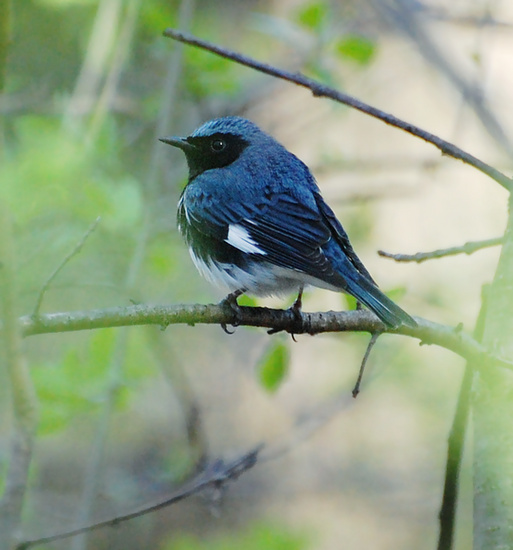
Palm Warblers are common migrants here, but rare breeders. Their favorite habitat is sphagnum bog, such as Mer Bleue, and that is in fact the only place in Ottawa to find them in summer.
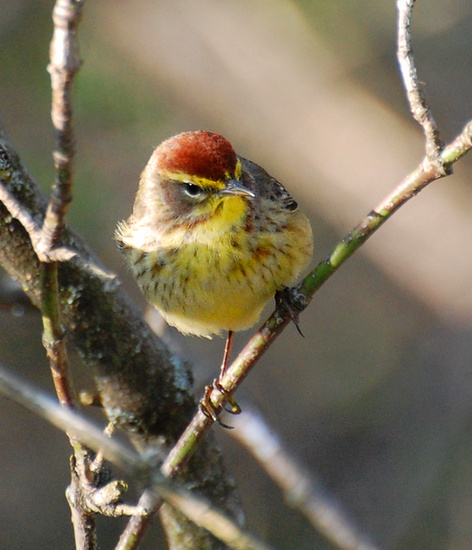
Ottawa birding is blowing my mind. I've never seen a spring like this. All of a sudden the land is exploding with birds--much the way it's exploding with color! I've seen and/or heard twenty new species between yesterday and today, including eight new warblers.
I also saw my first dragonflies, my first Black Swallowtail, my first ladybugs (eensy weensy ones crawling around on a dandelion), and got my first mosquito bite :-)
|
